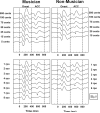Effects of Long-Term Musical Training on Cortical Auditory Evoked Potentials
- PMID: 28225736
- PMCID: PMC5325201
- DOI: 10.1097/AUD.0000000000000375
Effects of Long-Term Musical Training on Cortical Auditory Evoked Potentials
Abstract
Objective: Evidence suggests that musicians, as a group, have superior frequency resolution abilities when compared with nonmusicians. It is possible to assess auditory discrimination using either behavioral or electrophysiologic methods. The purpose of this study was to determine if the acoustic change complex (ACC) is sensitive enough to reflect the differences in spectral processing exhibited by musicians and nonmusicians.
Design: Twenty individuals (10 musicians and 10 nonmusicians) participated in this study. Pitch and spectral ripple discrimination were assessed using both behavioral and electrophysiologic methods. Behavioral measures were obtained using a standard three interval, forced choice procedure. The ACC was recorded and used as an objective (i.e., nonbehavioral) measure of discrimination between two auditory signals. The same stimuli were used for both psychophysical and electrophysiologic testing.
Results: As a group, musicians were able to detect smaller changes in pitch than nonmusician. They also were able to detect a shift in the position of the peaks and valleys in a ripple noise stimulus at higher ripple densities than non-musicians. ACC responses recorded from musicians were larger than those recorded from non-musicians when the amplitude of the ACC response was normalized to the amplitude of the onset response in each stimulus pair. Visual detection thresholds derived from the evoked potential data were better for musicians than non-musicians regardless of whether the task was discrimination of musical pitch or detection of a change in the frequency spectrum of the ripple noise stimuli. Behavioral measures of discrimination were generally more sensitive than the electrophysiologic measures; however, the two metrics were correlated.
Conclusions: Perhaps as a result of extensive training, musicians are better able to discriminate spectrally complex acoustic signals than nonmusicians. Those differences are evident not only in perceptual/behavioral tests but also in electrophysiologic measures of neural response at the level of the auditory cortex. While these results are based on observations made from normal-hearing listeners, they suggest that the ACC may provide a non-behavioral method of assessing auditory discrimination and as a result might prove useful in future studies that explore the efficacy of participation in a musically based, auditory training program perhaps geared toward pediatric or hearing-impaired listeners.
Figures







Similar articles
-
Preattentive cortical-evoked responses to pure tones, harmonic tones, and speech: influence of music training.Ear Hear. 2009 Aug;30(4):432-46. doi: 10.1097/AUD.0b013e3181a61bf2. Ear Hear. 2009. PMID: 19494778
-
Pitch discrimination accuracy in musicians vs nonmusicians: an event-related potential and behavioral study.Exp Brain Res. 2005 Feb;161(1):1-10. doi: 10.1007/s00221-004-2044-5. Epub 2004 Nov 13. Exp Brain Res. 2005. PMID: 15551089
-
Effects of musical training on the early auditory cortical representation of pitch transitions as indexed by change-N1.Eur J Neurosci. 2012 Dec;36(11):3580-92. doi: 10.1111/j.1460-9568.2012.08278.x. Epub 2012 Sep 7. Eur J Neurosci. 2012. PMID: 22958242
-
Effects of musical training on the auditory cortex in children.Ann N Y Acad Sci. 2003 Nov;999:506-13. doi: 10.1196/annals.1284.061. Ann N Y Acad Sci. 2003. PMID: 14681174 Review.
-
Specialization of the specialized: electrophysiological investigations in professional musicians.Ann N Y Acad Sci. 2003 Nov;999:131-9. doi: 10.1196/annals.1284.014. Ann N Y Acad Sci. 2003. PMID: 14681126 Review.
Cited by
-
Efferent Control in Musicians: A Review.Audiol Res. 2023 Jan 6;13(1):76-85. doi: 10.3390/audiolres13010007. Audiol Res. 2023. PMID: 36648928 Free PMC article. Review.
-
A Preliminary Study of the Effects of Attentive Music Listening on Cochlear Implant Users' Speech Perception, Quality of Life, and Behavioral and Objective Measures of Frequency Change Detection.Front Hum Neurosci. 2020 Mar 31;14:110. doi: 10.3389/fnhum.2020.00110. eCollection 2020. Front Hum Neurosci. 2020. PMID: 32296318 Free PMC article.
-
Changes in Speech-Related Brain Activity During Adaptation to Electro-Acoustic Hearing.Front Neurol. 2020 Mar 31;11:161. doi: 10.3389/fneur.2020.00161. eCollection 2020. Front Neurol. 2020. PMID: 32300327 Free PMC article.
-
Musicians do not benefit from differences in fundamental frequency when listening to speech in competing speech backgrounds.Sci Rep. 2017 Oct 3;7(1):12624. doi: 10.1038/s41598-017-12937-9. Sci Rep. 2017. PMID: 28974705 Free PMC article.
-
Hearing in categories and speech perception at the "cocktail party".PLoS One. 2025 Jan 30;20(1):e0318600. doi: 10.1371/journal.pone.0318600. eCollection 2025. PLoS One. 2025. PMID: 39883695 Free PMC article.
References
-
- Alain C, Snyder J, He Y, et al. Changes in auditory cortex parallel rapid perceptual learning. Cereb Cortex. 2007;17:1074–1084. - PubMed
-
- Besson M, Schön D, Moreno S, et al. Influence of musical expertise and musical training on pitch processing in music and language. Restor Neurol Neurosci. 2007;25:399–410. - PubMed
Publication types
MeSH terms
Grants and funding
LinkOut - more resources
Full Text Sources
Other Literature Sources
Research Materials

